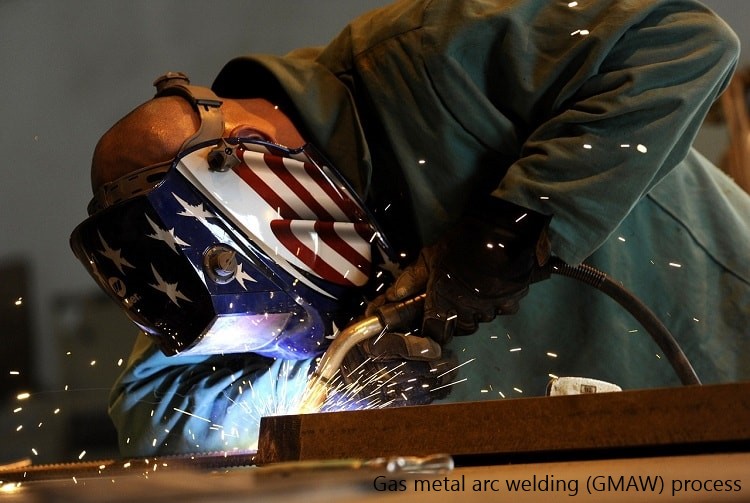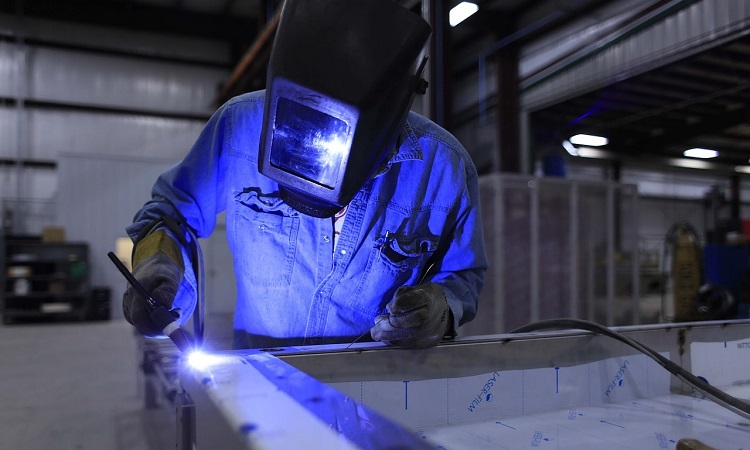Welding is one of the popular joining processes that has almost superseded other permanent joining processes including riveting. Intensive development of welding technique throughout last few decades makes it prominent choice for joining of metallic structures, plastics and even ceramics. By definition, welding is one of the joining processes that can permanently join two or more components by coalescence formation with or without the application of additional filler material, heat and pressure. There exist a wide variety of such processes to cater the need of assembling different materials in diverse ways. Such processes can be classified as arc welding, gas welding, resistance welding, solid state welding and intense energy welding. Each of these group again has several process. MIG and TIG welding are two different arc welding processes.
In arc welding, an electric arc is established in between parent metal and electrode. This arc is prime source of heat to melt down faying surfaces of base metal to form coalescence. Since base metals are required to fuse to achieve joining, so all arc welding processes are basically fusion welding. There are several arc welding processes such as manual metal arc welding (MMAW), gas metal arc welding (GMAW), gas tungsten arc welding (GTAW), submerged arc welding (SAW), flux core arc welding (FCAW), electro slag welding (ESW), etc. All of them are based on same principle in terms of joining technique, but their capability and process are different. Each of them offers certain advantages over others.

Gas metal arc welding (GMAW) is one highly productive fusion welding process where consumable electrode is continuously fed to the welding zone from a wire spool using an automated system. Arc, constituted between electrode and base metals under the presence of sufficient potential difference, fuses electrode at a faster rate and subsequently deposits on root gap to perpetuate the process. Proper shielding gas is also supplied to protect high temperature arc and surrounding areas from oxidation. Based on shielding gas property, GMAW can be of two types—metal active gas and metal inert gas. In metal inert gas (MIG) welding, a chemically inert gas (like argon, helium, etc.) is used for shielding purpose; while in metal active gas welding, a chemically active gas (like carbon di-oxide or oxygen) is mixed with inert gas to use for shielding purpose.
Gas tungsten arc welding (GTAW), popularly known as tungsten inert gas (TIG) welding, is a versatile and reliable fusion welding process that utilizes a non-consumable tungsten electrode to constitute the electric arc. Filler metal, if needed, can also be supplied externally by feeding a filer rod into welding zone. Unlike MIG welding, TIG welding is not suitable for high filler deposition rate; however, the quality of joint and appearance of weld bead is much better. Therefore both MIG and TIG welding are fusion welding processes where heat is supplied by an electric arc and both of them utilize inert gas as shielding gas. However, they are different in certain ways including the process and capability. Various differences between MIG welding and TIG welding are provided below in table format.
Table: Differences between MIG welding and TIG welding
| MIG welding | TIG welding |
|---|---|
| MIG welding is performed using a consumable electrode. | TIG welding is performed using a non-consumable electrode. |
| Electrode can be made of any competent metal. | Electrode is made of tungsten with some alloying elements. |
| Filler deposition rate is very high. So process is highly productive. | Filler deposition rate is comparatively low. |
| It produces spatter that causes loss of filler metal, poor appearance, etc. | It is free from spatter if optimum parameters are employed. |
| Autogenous welding mode is not possible as electrode is consumable. | It is preferred for autogenous mode; can also be applied for other modes. |
| It cannot be performed for overhead joining requirements. | It can be applied for overhead joining requirements. |
| MIG is simple and usually does not require highly trained welder. It is also very easy to control. | TIG is little difficult, especially establishing and maintaining the arc. So it requires experienced welder. |
Consumable and non-consumable electrode: A conductive electrode is mandatory in every arc welding process to constitute the arc. Sometimes this electrode itself deposits molten metal in root gap between base plates. A consumable electrode is one which can melt down by arc heat to deposit filler during welding. On the contrary, a non-consumable electrode is not expected melt down during welding and thus filler metal is required to supply externally whenever intended. In MIG welding, the consumable electrode melts down by arc heat and subsequently supplies filler metal. Thus electrode is continuously fed into welding zone at a pre-defined rate. TIG welding is performed using a non-consumable electrode and thus it does not melt down to supply filler. In case filler is desired, the same is supplied additionally by feeding a small diameter filler rod beneath the arc.

Electrode material: Filler material should be compatible with parent material, otherwise defective welding will be produced. With MIG welding, filler metal (same as electrode metal) can be chosen according to base metal. So electrode can be made of wide variety of metals, each one is usually suitable for a small group of base metals. In TIG welding, electrode is always made of tungsten because of its strength, high melting temperature and good shape retention capability. Sometimes few alloying elements are also added to (for example thorium, lanthanum oxide, cerium oxide, zirconia, etc.) with tungsten for improving various welding characteristics like electron emissivity, electrode erosion, etc.
Filler deposition rate and productivity: In MIG welding process, electrode in the form of small diameter wire that is wound in a pool is continuously fed by a proper mechanized arrangement. So filler can be deposited at a faster rate and consequently this welding process is highly productive as compared to TIG welding. Thus MIG welding is suitable when edge is prepared in V or U shaped or root gap is more.
Spatter level and appearance: Spatter is small droplets of molten filer metal that is produced due to scattering of arc and subsequently emerge out from the welding zone. This spatter causes loss of filler metal that leads to non-uniform filler deposition rate. It also destabilize the arc. Abruptly deposited molten metal droplets also hamper appearance and sometimes require grinding for its removal. Many arc welding processes produce spatter including GMAW (both MIG and MAG). Although MIG tends to produce low level spatter, it cannot be performed in spatter-free way even if optimum set of process parameters and proper welding technique are employed. TIG welding usually does not produce spatter unless the work material surface is not clean. Weld bead produced by TIG welding is clean, smooth and attractive.
Autogenous, homogenous and heterogeneous modes: On the basis of filler metal application and its composition, welding can be classified as autogenous, homogenous and heterogeneous modes. An autogenous mode of welding is performed without applying any filler metal. When root gap is virtually zero or very small then filler does not require. In homogeneous mode of welding, filler is applied and composition of filler is more or less same with that for parent metal. Filler is also applied in heterogeneous welding mode but composition of filler differs substantially from that of parent metal. Since consumable electrode is inherent to MIG welding, so it cannot be performed in autogenous mode. Contrary to this, TIG is suitable and preferred for such purpose. TIG can be also applied advantageously for homogenous and heterogeneous modes with optimum set of parameters.
Possibility for overhead joining: Welding position includes down-hand, inclined, overhead, etc. Overhead joining position is very difficult to execute as filler is required to deposit against to gravity. Molten metal pool always has a tendency to fall down and it can even injure welder. Thus gravitational force alone is not suitable for proper filler deposition; in fact, it imposes restriction. Lorentz force helps in such situation. TIG welding with optimum set of parameters can be employed for overhead welding. However, it requires experienced welder to achieve good penetration and welding quality.
Scientific comparison among metal inert gas (MIG) welding and tungsten inert gas (TIG) welding is presented in this article. The author also suggests you to go through the following references for better understanding of the topic.
- Gas Metal Arc Welding Handbook by W. H. Minnick (2007, Goodheart Willcox).
- Basic TIG & MIG Welding (GTAW & GMAW) by I. H. Griffin, E. M. Roden and C. W. Briggs (3rd edition, Delmar Cengage Learning).

